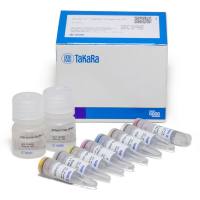Identification of MAPK Substrates by Expression Screening With Solid-Phase Phosphorylation
互联网
385
The biologic activities of protein kinases result from phosphorylation of their substrate proteins. Phosphorylation of proteins causes changes in structure, stability, enzymatic activity, ability to interact with other molecules, or subcellular localization, leading to regulation of a wide variety of cellular processes. Indeed, identification of physiologic targets has been a high priority ever since the first protein kinase was purified, but the conventional approach of purifying substrate proteins by biochemical techniques is a laborious and time-consuming task and is especially difficult in the case of scarce proteins. Among the approaches developed to identify protein kinase substrates in a systematic manner are various techniques for determining consensus phosphorylation site sequences using oriented peptide libraries (1 –3 ); interaction screening for protein substrates by an overlay method (4 ,5 ); the yeast two-hybrid system (6 ,7 ); and, more recently, the use of protein kinases engineered to accept unnatural adenosine triphosphate (ATP) analogs (8 –10 ); or protein kinase arrays (11 ).









